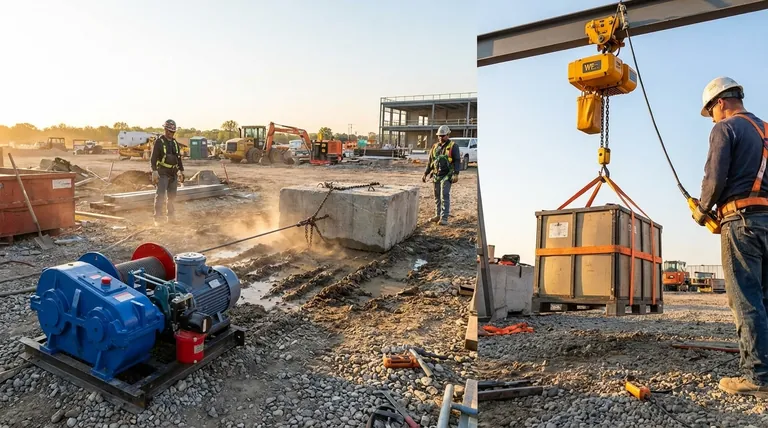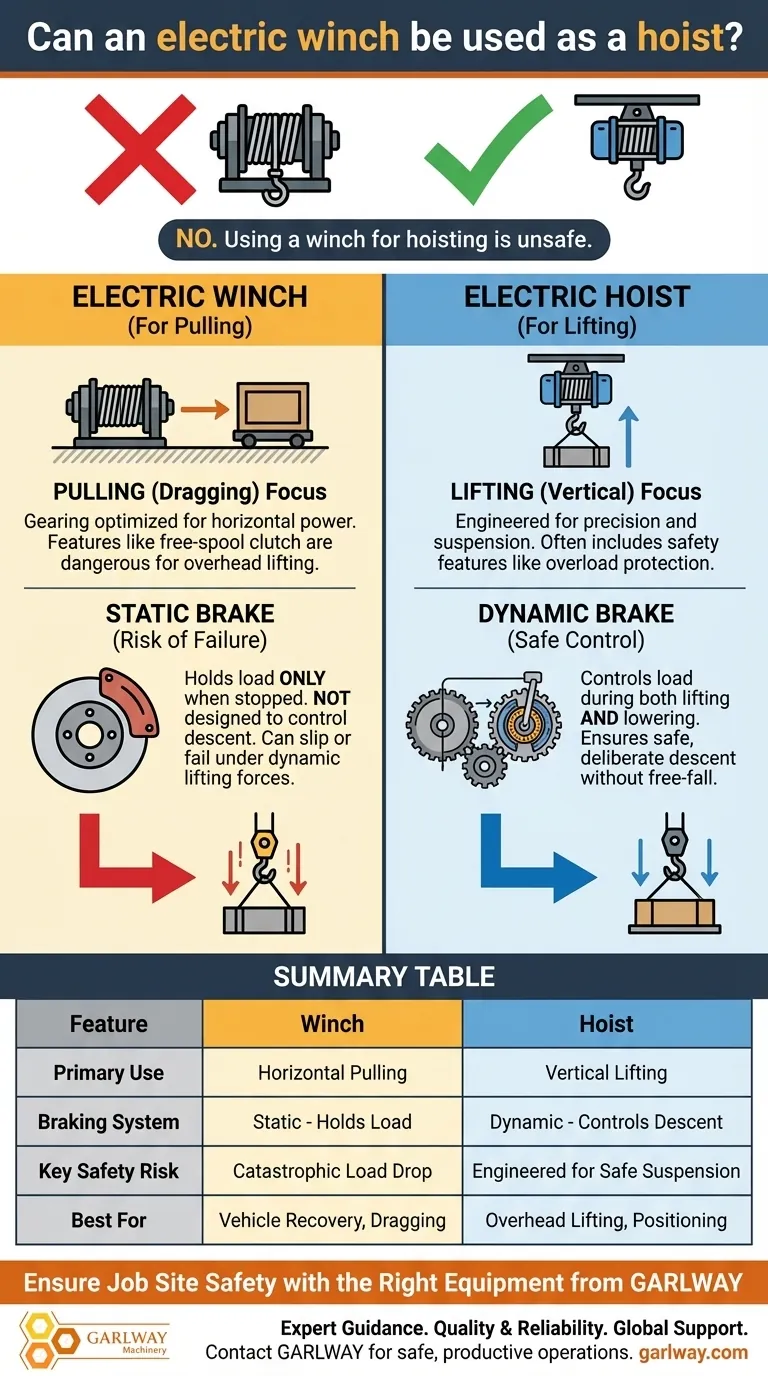Using a standard electric winch as a hoist is unsafe and is a practice that should be avoided. While they appear functionally similar, winches are fundamentally designed for pulling loads horizontally, whereas hoists are specifically engineered for the unique stresses and safety requirements of lifting loads vertically. The critical distinction lies in their internal braking systems and gear trains, which determine their suitability and safety for any overhead lifting application.
The core difference is the braking system: A true hoist uses a dynamic braking system designed to safely suspend, position, and lower a load under power. Most standard winches use a static brake only meant to hold a load, not control its descent, creating a significant risk of failure and catastrophic load drops if used for vertical lifting.

The Core Difference: Pulling vs. Lifting
The confusion between winches and hoists is understandable, as both use a motor and cable to move a heavy object. However, their internal engineering is optimized for entirely different force dynamics.
The Winch's Design Philosophy
A winch is designed for pulling, also known as dragging. Its gearing is optimized for power to overcome the friction of a load being pulled across a surface.
Features like a free-spool clutch are designed for quickly pulling out cable to attach to a load, a common need in vehicle recovery or horizontal pulling scenarios, but a dangerous feature in an overhead lifting context.
The Hoist's Design Philosophy
A hoist is engineered exclusively for vertical lifting. Its primary design concerns are precision, control, and the ability to safely suspend a load in mid-air indefinitely.
Hoists often include critical safety features not found on standard winches, such as variable speed control for precise positioning and overload protection to prevent lifting a load that exceeds the equipment's rated capacity.
The Braking System: The Most Critical Distinction
The single most important safety difference between these two tools is how they manage the load when the motor is not actively lifting.
Static Brakes in Winches
Most winches use a simple static brake. This brake is designed to engage and hold a load once the pulling stops. It is not designed to handle the heat and mechanical stress generated by "powering out" or lowering a heavy, suspended load.
Attempting to lower a load with a winch brake can cause it to slip or fail completely, as it was never intended to manage a load's descent against gravity.
Dynamic Brakes in Hoists
Hoists use dynamic braking systems, often a mechanical load brake. This type of brake is specifically engineered to handle the dynamic forces of both lifting and lowering a suspended load under full control.
This system ensures that if power is lost or the motor stops, the load is held securely in place and can be lowered safely and deliberately without risk of free-fall.
Understanding the Risks and Trade-offs
Using the wrong tool for an overhead lift introduces significant and often unacceptable risks. While some specialized winches can lift, it's critical to understand the limitations.
The Danger of Component Failure
The gearbox and bearings in a winch are built to withstand the forces of horizontal pulling. The direct, perpendicular force of gravity in a vertical lift places a different and more intense strain on these components, increasing the risk of mechanical failure.
Lack of Precision and Control
A winch is typically designed for raw power and speed, not the slow, methodical positioning required when hoisting valuable or dangerous materials. This can lead to load damage or accidents.
The Exception: Winches Rated for Lifting
Some manufacturers produce winches that are explicitly rated for lifting or hoisting applications. These are not standard winches; they are specialized hybrid tools equipped with the necessary dynamic braking systems and more robust gear trains.
Unless a winch is explicitly marked and certified by the manufacturer for vertical lifting, it must be assumed it is for pulling only.
Making the Right Choice for Your Application
To ensure safety and efficiency, you must select your equipment based on the specific task at hand, not on superficial similarities.
- If your primary focus is safety and precision in vertical lifting: Always choose a dedicated electric hoist designed for that purpose.
- If your primary focus is pulling a load horizontally across a surface: A standard electric winch is the correct and most efficient tool.
- If you have a specialized, long-distance vertical lifting need (e.g., rooftop work): You must source a winch that is explicitly rated and engineered for vertical hoisting, equipped with a proper dynamic braking system.
Ultimately, matching the tool's core design to the task is not just about efficiency—it is a non-negotiable component of operational safety.
Summary Table:
| Feature | Electric Winch | Electric Hoist |
|---|---|---|
| Primary Use | Horizontal Pulling (Dragging) | Vertical Lifting |
| Braking System | Static Brake (Holds Load) | Dynamic Brake (Controls Descent) |
| Key Safety Risk | Catastrophic Load Drop if Used for Lifting | Engineered for Safe Suspension & Lowering |
| Best For | Vehicle Recovery, Horizontal Pulling | Overhead Lifting, Precise Load Positioning |
Ensure Job Site Safety with the Right Equipment from GARLWAY
Choosing the correct tool is critical for safety and efficiency. GARLWAY specializes in providing robust and reliable construction machinery, including dedicated electric hoists and winches, for construction companies and contractors worldwide.
Why Partner with GARLWAY?
- Expert Guidance: Get the right equipment tailored to your specific lifting or pulling needs.
- Quality & Reliability: Our hoists are engineered with dynamic braking systems for safe vertical lifting, while our winches deliver powerful horizontal pulling performance.
- Global Support: We support your projects with dependable machinery and service.
Don't compromise on safety. Let our experts help you select the perfect solution for your application.
Contact GARLWAY today for a consultation and ensure your operations are both safe and productive.
Visual Guide

Related Products
- Electric and Hydraulic Winch for Heavy Duty Applications
- Electric 120V Boat Winch by Badlands
- 12000 lb Heavy Duty Electric Boat Winch
- Electric Hoist Winch Boat Anchor Windlass for Marine Applications
- Heavy Duty Electric Boat Winch Windlass Anchor
People Also Ask
- How is an electric winch powered? Unlock the Power Conversion System for Heavy Lifting
- How to power an electric winch on a trailer? Choose the Best Method for Your Setup
- Can you use an electric winch manually? A Guide to Dual-Functionality Winches
- How long can you run an electric winch? Master Safe, Efficient Vehicle Recovery
- How does the electric winch work? Unlock the Power of Force Multiplication



















